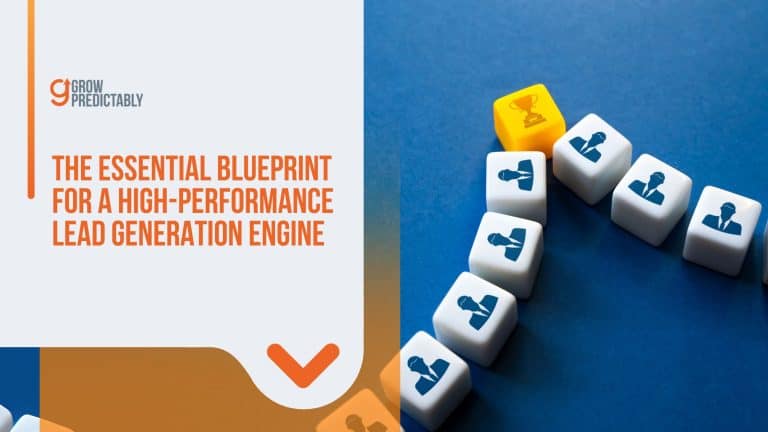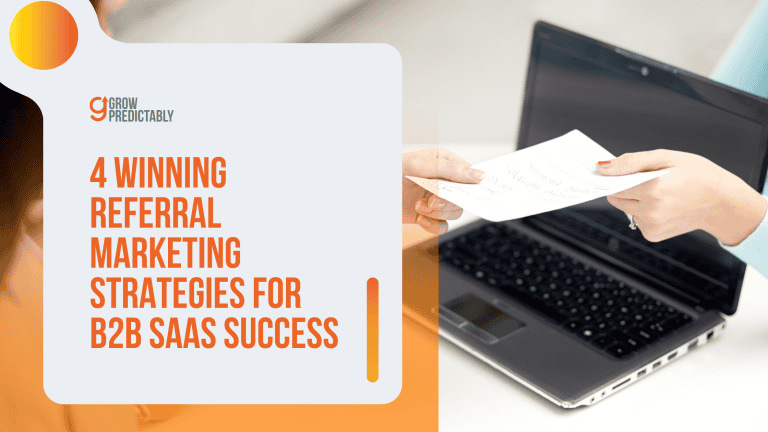5 Ways to Leverage Emotional Intelligence in B2B Sales
You follow the playbook, make the calls, and handle objections. But something’s missing.
Your prospects hesitate, deals stall, and clients don’t see you as a trusted advisor.
The missing piece? Emotional intelligence in B2B sales—the skill that turns sales reps into top performers.
With EI, you build connections that competitors can’t replicate.
What’s the most overlooked technique that closes deals faster?
Let’s find out!
We’re also going to look into a tool that can supercharge any B2B sales reps’ efforts on championing emotional intelligence in sales.
The Components of Emotional Intelligence
Emotional Intelligence (EI), also known as emotional quotient (EQ), encompasses the capacity to be aware of, control, and express one’s emotions and to handle interpersonal relationships judiciously and empathetically.
In the high-stakes environment of B2B sales, professionals equipped with strong emotional intelligence skills are often more successful.
They possess the nuanced ability to read the room, interpret the emotional currents of conversations, and respond appropriately.
This emotional intelligence skill set is essential not just for winning immediate sales but also for cultivating deeper, more strategic relationships that benefit both seller and buyer in the long term.
High EI enables sales professionals to manage their own emotions effectively, navigating complex business landscapes where understanding client motivations and managing personal reactions can make or break deals.
It ensures that negotiations, aided by emotional intelligence skills, are handled with a sensitivity that fosters both respect and trust, laying the groundwork for future interactions.
In essence, sales professionals who hone their emotional intelligence skills don’t just sell; they leverage their emotional intelligence to build lasting partnerships that can evolve with the changing needs of both their clients and the market.
High emotional intelligence requires the following key components:
- Self-Awareness: Self-awareness is the foundational element of EI, involving an understanding of one’s emotions, strengths, weaknesses, and the effects of these on others. B2B sales professionals high in self-awareness can accurately assess situations to tailor their approach, thus avoiding potential conflicts and miscommunications.
- Empathy: Empathy demonstrates how emotional intelligence strengthens client relationships when sales professionals manage their own emotions and share the feelings of their clients. This understanding is critical in addressing clients’ needs effectively and building trust, which is pivotal in forming lasting business relationships.
- Social Skills: Proficiency in managing relationships and building networks is what defines social skills. For sales professionals, this means better teamwork, efficient conflict resolution, and more effective communication, leading to smoother transactions and negotiations.
- Emotional Regulation: This involves controlling one’s own emotions and adapting to changing circumstances with calm. Sales professionals skilled in emotional regulation are better equipped to handle stress, rejections, and high-pressure situations, maintaining professionalism throughout.
Lacking EI can lead to misunderstanding clients’ needs, ineffective communication, and, ultimately, the loss of potential deals.
For B2B brands, poor emotional intelligence in sales teams can result in damaged relationships and a tarnished brand reputation, underscoring the importance of investing in EI development to enhance overall business performance.
Build Trust and Relationships Through Emotional Intelligence
Leveraging emotional intelligence (EI) makes a huge difference in B2B sales relationships.
When you use EI well, your clients start seeing you as someone they can count on, not just another sales rep trying to close a deal.
Active Listening
The first step is active listening – and we mean really listening, not just waiting for your turn to talk.
You need to pick up on what your clients are worried about, even when they don’t say it directly.
Notice their tone of voice, pay attention to what gets them excited, and spot signs of concern.
This helps you understand what matters to them beyond just the business stuff.
Understanding the Client’s Business
You also need to get what makes their company tick.
Each business has its own way of doing things and its own set of problems to solve.
With high emotional intelligence, when you show that you understand these things, clients feel like you’re on their team.
Building Trust with Emotional Intelligence Skills
Here are six things you can do right now to build trust with EI:
- Stop and listen more than you talk.
- Let your clients finish their thoughts without jumping in.
- Ask questions about their company culture and challenges.
- Show genuine interest in their answers.
- Do what you say you’ll do every single time.
- Follow up when promised and keep your commitments.
By focusing on trust building, you’ll see how emotional intelligence helps strengthen business relationships.
The Importance of Reliability in Client Relationships

Being reliable is a big deal in B2B sales.
When you consistently show up, follow through, and really get your clients, you’ll see how emotional intelligence builds lasting connections.
Plus, they’ll tell others about you – and that’s how you build a solid network of happy customers who trust you.
Long-Lasting Relationships
Remember, trust doesn’t happen overnight.
But when you use EI to guide how you work with clients, you create relationships that last way longer than any single sale.
Use Active Listening to Understand Client Needs
Active listening isn’t just about hearing the words another person says.
It’s about fully engaging with them and understanding the message behind the words.
To practice active listening involves paying close attention not only to the speaker’s words but also to their tone, pace, and body language, aiming to grasp the total meaning based on content and underlying sentiments.
Carl Rogers, one of the founders of humanistic psychology, defines active listening as a communication technique where a listener fully attends to the speaker, attempting to grasp both the content and underlying feelings of their message, and then reflects back that understanding to the speaker to ensure accurate comprehension, demonstrating empathy and fostering a deeper connection; essentially, it’s about “listening with the intent to understand” rather than just to respond.
When individuals feel genuinely heard, it goes deeper than just a good conversation—psychologically, it can significantly impact their attitude towards themselves and others.
This can lead to changes in their basic values and personal philosophy.
Key Points from Carl Roger’s Definition of Active Listening
Here are four ways to summarize Carl’s views on how active listening can be fostered in any setting.
- Empathy is central: Active listening involves trying to see the situation from the speaker’s perspective and understanding their emotions.
- Non-judgmental approach: The listener should avoid interrupting or judging the speaker’s thoughts and feelings.
- Verbal and non-verbal cues: Active listening involves paying attention to both the speaker’s words and their body language.
- Reflecting back: A key aspect of active listening is paraphrasing or summarizing what the speaker has said to confirm understanding.
In the context of B2B sales, when a sales rep practices active listening, it helps create a trustworthy relationship with prospects.
Prospects who feel heard are more likely to open up about real needs and pains, leading to more bespoke solutions and, ultimately, more successful sales outcomes.
So, how can B2B sales professionals harness active listening in daily interactions?
Here are a few straightforward tips:
- Focus Fully: During discussions, sales reps should give their undivided attention to the prospects, avoiding distractions like phones or laptops. This signals respect and interest.
- Echo Back: After hearing the client, paraphrase what was said to confirm understanding. This step reduces misunderstandings and shows the client that they are being heard correctly.
- Ask Insightful Questions: These should be questions that encourage the prospect to explain further. It’s about peeling back layers to reach the core of what the client really needs.
- Read Non-Verbal Cues: Often, body language, facial expressions, and voice tone say more than words. Observing these can give clues about the client’s true thoughts and feelings.
- Pause Before Replying: Instead of jumping in with a solution or a counter-point, taking a brief pause allows the client to express fully and shows that the rep is digesting the information, not just waiting to speak.
By actively listening, sales reps can understand their clients more deeply, leading to solutions that are tailored specifically to their needs, which builds long-term relationships and increases sales effectiveness.
Such a strategy not only benefits the sales process but reinforces a company’s reputation as one that truly listens and responds to its customers.
Use active listening to understand client needs and see how emotional intelligence helps in enhancing client understanding.
Leverage Empathy to Connect with Clients
Developing emotional intelligence or empathy in B2B sales means putting yourself in your client’s shoes to really get what makes them tick.
This skill helps you pick up on their worries, needs, and goals – even the ones they don’t say out loud.
When you show genuine empathy, a key aspect of emotional intelligence, clients feel understood and valued, which builds real connections that last.
With empathy, sales becomes not just a transaction but a door toward a future where you and your client solve their problems together.
One way to empathize more efficiently with your customers is to get to know them, one thing that the late Steve Jobs perfected, helping Apple become one of the greatest household names in tech.
Get closer than ever to your customers. So close that you tell them what they need well before they realize it themselves.
Steve Jobs
Here’s a tool that will help you do that.
The Customer Avatar Canvas
The Customer Avatar Canvas gives you a clear picture of who your client really is.
Think of it as a map of their business mind and emotions.
The Customer Avatar Canvas can help you map essential details about your target audience.
We’ll dive deeper into what this canvas is all about, but for now, here’s a glimpse of how this tool can help you champion empathy in B2B sales:
Map Out Their Worries
- Write down what keeps them up at night about their business.
- Note their biggest work headaches and daily frustrations.
- List the problems they’re trying to fix right now.
Understand What Drives Them
- Figure out their main business goals.
- Identify what success looks like to them.
- Know what would make their job easier or better.
Exercise to Sharpen Empathy Skills
Try this quick exercise to sharpen your empathy skills:
- Pick a current client.
- Fill out their avatar with everything you know about them.
- Add notes from your past conversations.
- Look for gaps in your understanding.
- Plan questions to fill those gaps in your next meeting.
The more you know about your clients’ world, the better you can match your solutions to their actual needs.
This isn’t about faking interest – it’s about truly getting why they do what they do.
When clients sense you really get their situation, they’re more open to hearing your ideas.
They stop seeing you as just another vendor and start seeing you as someone who actually cares about their success.
The Essence of Good Empathy
Remember: Good empathy isn’t just nodding and saying, “I understand.”
It shows clients you’ve done your homework, and you’re ready to help solve their specific problems.
Harnessing the Power of the Customer Avatar Canvas in B2B Sales
The Customer Avatar Canvas is a strategic framework designed to deep dive into the profile of an ideal client, detailing everything from basic demographic information to sophisticated psychographics and specific needs.
This canvas helps B2B sales professionals pinpoint exactly who their customers are, what they need, and how they feel before and after using a product or service.

Major sections of the Customer Avatar Canvas include:
- Demographics: Information about age, job, income, and more that gives a factual base.
- Psychographics: Details on personality, values, and lifestyles which influence buying behaviors.
- Needs and Goals: Understanding what the customer is actively trying to achieve.
- Challenges and Pain Points: Identifying the obstacles that your client faces.
- Before/After: How the customer’s situation changes due to your product/service—key for emotional connection.
Using this tool effectively can supercharge B2B professionals by allowing them to leverage their emotional intelligence to foster stronger connections.
A well-crafted customer avatar enables sales reps to communicate more naturally with prospects, as they can tailor interactions to the specific emotional and practical needs of the client.
Examples of how the Customer Avatar Canvas can be utilized by B2B sales professionals include:
- Tailored Pitches: Using knowledge from the canvas, sales reps can create pitches that directly address a prospect’s specific business pain points and aspirations.
- Empathy in Sales Calls: Understanding the emotional state of a client pre and post-purchase allows reps to express genuine empathy, a critical component in building trust.
- Persuasive Use Cases: By understanding where a client started and where they could go with your solution, reps can articulate compelling use cases during sales transactions.
In essence, the Customer Avatar Canvas helps B2B professionals not just meet but exceed client expectations by delivering personalized, empathetic interactions that are informed by a deep understanding of the client’s background, challenges, and desires.
This strategic approach significantly enhances sales effectiveness and client satisfaction all while leveraging emotional intelligence.
Manage Emotions Under Pressure
In B2B sales, staying in control of your emotions isn’t just a personal benefit—it’s crucial for controlling the transaction itself.
When sales professionals maintain their composure, they are better able to manage discussions and steer transactions in the desired direction, ensuring both parties feel confident and valued throughout the process.
However, when sales reps fail to regulate their emotions, the stakes can be high.
Losing control can lead to damaged relationships, lost sales, and a tarnished professional reputation.
Emotional outbursts or visible anxiety can undermine a client’s trust in the salesperson’s competence and stability, thus jeopardizing potential deals.

Common reasons why we sometimes lose control under pressure in sales scenarios:
- Fear of Rejection: Worrying about being turned down can make you anxious and defensive.
- High-Performance Expectations: Pressure to meet sales targets can increase stress levels.
- Complex Negotiations: Challenging discussions with tough clients can trigger frustration.
- Personal Problems: External stresses can impact professional demeanor.
- Lack of Preparation: Being unprepared can lead to panic and stress in important meetings.
To effectively manage own emotions under pressure, especially during critical sales transactions, B2B professionals can follow these expert tips:
- Prepare Thoroughly: Understanding the client’s needs, the details of your product or service, and the competitive landscape can reduce anxiety and boost confidence.
- Practice Mindfulness: Techniques such as deep breathing or mindfulness can calm the mind and help maintain emotional balance during high-pressure situations.
- Stay Positive: Maintaining a positive attitude helps prevent being overwhelmed by negative emotions. Focus on solutions rather than problems.
- Use Active Listening: Enhanced self-awareness from this practice helps in regulating your emotional responses based on the conversation’s flow.
- Reflect and Learn: After each client interaction, reflect on what went well and what didn’t. Learning from each experience can improve emotional responses in future interactions.
- Seek Feedback: Constructive criticism from peers or mentors can provide insights into improving emotional control during sales presentations and negotiations.
By developing emotional intelligence and mastering these techniques, B2B sales professionals can better manage their emotions, lead discussions more effectively, and close deals successfully even under pressure.
High emotional intelligence is about managing emotions not just to prevent negatives but also to harness a calm, confident demeanor fostering positive client interactions.
In addition to these expert practices in staying regulated and in control during moments of pressure in sales, try to keep this checklist on hand or personalize it.
Your Pressure-Proof Checklist
□ Start meetings with a centering breath.
□ Notice tension in your body and consciously relax.
□ Speak at a measured pace.
□ Take breaks between calls.
□ Keep a “wins” folder ready for tough days.
The key is catching yourself before emotions take over.
With practice, these techniques become automatic.
You’ll handle pressure better and close more deals because you stay professional when others might crack.
REMEMBER: The best salespeople aren’t the ones who never feel pressure – they’re the ones who know how to work with it.
Use Emotional Intelligence to Frame Your Sales Pitches
High emotional intelligence makes a huge difference in how well your sales pitch resonates with potential clients.
The Customer Avatar Canvas will help you do just that—tapping into what really matters to your clients: their worries, hopes, and goals.
Addressing Client Concerns
When you know what keeps your clients up at night, you can speak directly to those concerns.
The ‘Fears and Frustrations’ part of the Customer Avatar Canvas shows you exactly what bothers them.
Maybe they’re worried about falling behind competitors or wasting their budget.
Your pitch needs to address these fears head-on.
Highlighting Client Goals
The ‘Wants and Aspirations’ section is just as important.
Your clients have specific goals – like growing their market share or making their teams more productive.
When you understand these goals, you can show how your product helps them get there.
Tips for an Emotionally Smart Pitch
To make your pitch more emotionally smart:
- Start with the client’s biggest worry.
- Share a story about how another client solved that same problem.
- Show specific results and numbers.
- Paint a picture of what success looks like for them.
Tailoring Communication Styles
Remember to match your client’s communication style.
If they’re all about numbers, give them data.
If they like stories, share relevant examples.
Your pitch should feel like it was made just for them.
QUICK TIP: Before your next pitch, spend 15 minutes filling out a Customer Avatar Canvas for your client.
Focus on their emotional drivers, not just their business needs.
Champion Emotional Intelligence in Different Stages of the Customer Journey
Your customers go through different stages before they become your biggest fans.
At each stage, you can use emotional intelligence to build stronger connections.
First Contact
Start with the basics during your first contact.
Pay attention to how prospects talk and what matters to them.
Mirror their communication style, but keep it real.
When you show you get them, they’re more likely to trust you.
Closing Deals
When you’re trying to close deals, use what you’ve learned about their feelings and concerns.
Maybe they’re worried about budget cuts or team pushback.
Address these head-on with understanding, not just facts and figures.
Post-Sale Connection
After the sale, keep that emotional connection going.
Check-in regularly, but not just about business.
Remember the personal details they’ve shared.
Emotional intelligence helps when clients feel truly understood, turning them into your biggest supporters and business advocates.
Challenge for Improvement
Want to get better at this?
Here’s a simple challenge: In your next sales call, focus only on listening and understanding before you pitch anything.
Write down what you learn about your prospect’s emotions and concerns.
Remember – emotional intelligence isn’t complicated.
It’s about being human and really getting your customers.
Try it tomorrow.
You might be surprised how much better your sales conversations go.
FAQs
The Competitive Edge of Emotional Intelligence
Mastering emotional intelligence isn’t just about being a better salesperson—it’s about building meaningful relationships that drive long-term success.
From self-awareness to empathy and emotion regulation, these skills enable you to connect with clients, handle objections gracefully, and ultimately close more deals.
By honing your EI, you shift from simply selling products to offering solutions that truly resonate with your clients’ real needs.
Imagine how much more effective your sales conversations could be if every client felt heard, understood, and valued.
Now it’s your turn.
Start by practicing active listening in your next call—pause before responding, focus on your client’s concerns, and ask deeper questions.
How do you currently use emotional intelligence in your sales process? Let us know in the comments—your insights could help others improve too.
The most successful salespeople aren’t just closing deals—they’re creating lasting partnerships.








